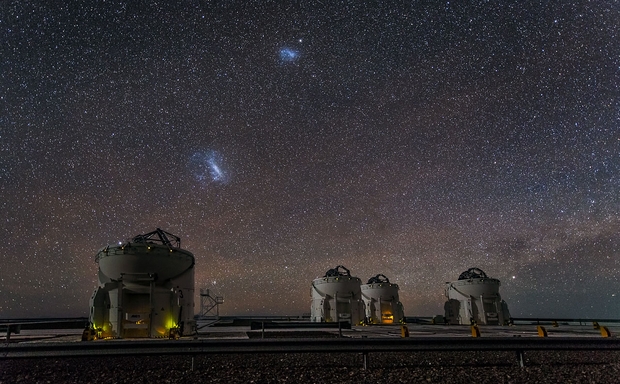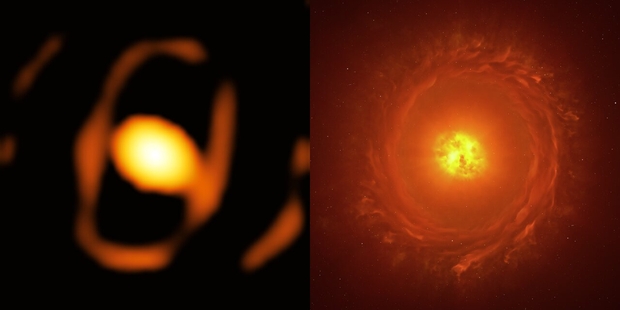While working on a piece about interstellar migration as a response to the accelerating expansion of the universe for next week, I want to pause a moment on a just announced observation. I’ve always had a fascination with the Magellanics, those satellite galaxies that are so useful to astronomers because their gravitational interactions with the Milky Way render both of them irregular in shape. That triggers waves of star formation and tells us something about how galaxies assemble themselves. The Small Magellanic Cloud (SMC), about 200,000 light years away, shows little structure, while the Large Magellanic (LMC) is a bit more organized but lacks symmetry – no smooth disk apparent there.

Image: This beautiful image taken at ESO’s Paranal Observatory shows the four Auxiliary Telescopes of the Very Large Telescope (VLT) Array, set against an incredibly starry backdrop on Cerro Paranal in Chile. The Auxiliary Telescopes are each 1.8 metres in diameter and work with the four 8.2-metre diameter Unit Telescopes to make up the world’s most advanced optical observatory. The telescopes work together to form the VLT Interferometer (VLTI), a giant interferometer which allows astronomers to see details up to 25 times finer than would be possible with the individual Unit Telescopes. Hanging over the site are the prominent Small and Large Magellanic Clouds, visible only in the southern sky. These two irregular dwarf galaxies are in the Local Group and so are companion galaxies to our own galaxy, the Milky Way. The image was taken by John Colosimo, who submitted it to the Your ESO Pictures Flickr group. Credit: ESO/J. Colosimo.
Within the LMC, some 160,000 light years away, astronomers have just imaged a rapidly evolving star, a fascinating catch because the object is dying and we apparently see it just before a supernova event. The telltale sign is the massive ejection of stellar material. The work was done with the European Southern Observatory’s Very Large Telescope Interferometer (VLTI), which combines the light collected by four telescopes, using the GRAVITY interferometer, correcting for atmospheric turbulence and providing imaging at four-milliarcsecond resolution. The effect is to produce the spatial resolution of a telescope of up to 130 meters in diameter depending on direction in the sky.
Long-studied and known as the ‘behemoth star,’ WOH G64 has shown surprising changes over a relatively short period of time. Keiichi Ohnaka (Universidad Andrés Bello, Chile) describes a star that is blowing out gas and dust in the last stages of its progress toward becoming a supernova: “We discovered an egg-shaped cocoon closely surrounding the star. We are excited because this may be related to the drastic ejection of material from the dying star before a supernova explosion.” Co-author Jacco van Loon (Keele University, UK) adds: “This star is one of the most extreme of its kind, and any drastic change may bring it closer to an explosive end.”
Shedding their outer layers, a red supergiant may take thousands of years to lose material before a supernova actually occurs. According to the paper, red supergiants like WOH G64 experience mass loss rates as high as ∼10−4 M☉ yr−1 — that means the star at this stage is losing on the order of 0.0001 solar masses of material every year. Recent work on other supernovae tell us that the mass-loss rate increases significantly just before the supernova event. It’s also intriguing that some red supergiants at this point of development show mass loss that is not symmetric. As far as I can find, the explanation is that the star is likely interacting with a binary companion. And indeed the paper notes:
The compact emission imaged with GRAVITY and the near-infrared spectral change suggest the formation of hot new dust close to the star, which gives rise to the monotonically rising near-infrared continuum and the high obscuration of the central star. The elongation of the emission may be due to the presence of a bipolar outflow or effects of an unseen companion.

Image: Located in the Large Magellanic Cloud, at a staggering distance of over 160 000 light-years from us, WOH G64 is a dying star roughly 2000 times the size of the Sun. This image of the star (left) is the first close-up picture of a star outside our galaxy. This breakthrough was possible thanks to the European Southern Observatory’s Very Large Telescope Interferometer (ESO’s VLTI), located in Chile. The new image, taken with the VLTI’s GRAVITY instrument, shows that the star is enveloped in a large egg-shaped dust cocoon. The image on the right shows an artist’s impression reconstructing the geometry of the structures around the star, including the bright oval envelope and a fainter dusty torus. Confirming the presence and shape of this torus will require additional observations. Credit: ESO/K. Ohnaka et al., L. Calçada.
I suspect that Centauri Dreams readers will remember the Large Magellanic Cloud as the apparent next destination of the interstellar interloper Rama in Arthur C. Clarke’s Rendezvous with Rama (1973). My own favorite reference is Iain Banks’ The Player of Games (2009), where an incredibly complex gaming strategy must be tackled by the protagonist within a strange empire in the Small Magellanic Cloud. Whatever your preference, the Masgellanics continue to fascinate, and we should learn more from the VLTI as the upgraded GRAVITY+ comes online.
The paper is Ohnaka et al., “Imaging the innermost circumstellar environment of the red supergiant WOH G64 in the Large Magellanic Cloud,” Astronomy & Astrophysics 14 October 2024 (letter to the editor). Abstract.



Is there any indication of when this star will go supernova? Are we talking years/centuries/millennia/longer?
[I was pleased to see the link is to the full paper, not just the abstract.]
From the Guardian newspaper article First close-up image of a star outside Milky Way shows supergiant in ‘cocoon’:
It’s the size of the ejections and mass of the star that allow us to differentiate between large stars that are preparing for a supernova explosion and a red giant from a G class star. Interesting. I asked Open AI chat GPT because I didn’t know and I was curious although I had an intuitive idea that was the reason.
The ejections from a supernova class star are much larger.
Thank you for this fascinating read, it is amazing that we are able to observe and study stars across such vastness of space, and yet, this is just a begging with new telescopes on the horizon.
It’s a fascinating thing to think about — so different from our notion of what a “star” is. If the Wikipedia stats can be trusted – please do correct me if I’m wrong here – it’s 25 times heavier than the Sun, with maybe 6 solar masses of expelled material out to a light year around it – so already about 20% evaporated. But apparently red supergiants have to get down to 10 solar masses before they can blow up. It’s 282,000 times brighter than the Sun, which sounds impressive, but since it is 1540 times bigger than the Sun in radius, that would actually be 2,370,000 times brighter than the Sun if it weren’t just 11% the brightness “per square foot” due to its lower temperature. The star’s radius, 7.1 AU, puts it well beyond the orbit of Jupiter, which is why we can see it even in another galaxy. So its surface gravity is roughly comparable to solar tides on Earth, no more than 1/1000 of a gee… explaining how it manages to keep losing all that mass.
But the weirdest thing to contemplate is that while all this is going on, with all those layers of near-viable star stuff puffed so far out, the whole thing is being lit by an ever-contracting core whose inability to carry out fusion is causing it to pull in on itself ever tighter, and powering all that light from the outer envelope!
Yeah! I loved Rendezvous with Rama a lot, having read it in Fall 2020, I see, yet I can find no review of mine (which I usually do, and I remember this book being extraordinarily to my like). Good thing, though, I just realized there are follow-ups to this one! I must have forgotten this.
And “The player of games” is so far in my view the best from Iain Banks’ Culture-Series. Yeah, that was a game in that book.
So despite the great news about a probably supernova, your article took me on a memory trip of SciFi books. Thanks.
At first it seemed the “extragalactic” star might be not within any galaxy, sort of like a rogue planet would be on a smaller scale. Then I understood that it referred to being outside just the Milky Way galaxy.
Maybe such rogue stars might have planetary entourages?
Do we have any idea how much distance there is between the “edge” of the Milky Way and the nearest “edge” of either of the Magellanic Cloud galaxies? All I find is the distance from Earth.
@Stephen
A rough (non-astronomer’s) estimate is to use our approximate position in the galaxy (about 3/4 of the Milky Way’s radius out from the center) and add or subtract the position from the “distance from Earth to the Magellanic galaxies”.
As our galaxy rotates over 1/4 of a billion years, the edge-to-edge distance will vary from reducing the distance by 1/4 when our sun is closest to the Magellanic cloud, to adding our galaxies radius to the distance when our sun is furthest from the Magellanic cloud. The distance to the Magellanic clouds will vary too given their interaction with our galaxy.
This is my interpretation of how to answer your question. Does that help? As
our galaxy size and our position from the center, and the distance to the Magellanic clouds. Astronomer commenters can provide better answers.
The science fictional analogy I thought of was Poul Anderson’s WORLD WITHOUT STARS, in which human explorers from our galaxy tried to reach an ancient, ancient star deep in the nearly starless spaces between galaxies. Instead they crash landed on one of the planets orbiting that star. The story is not set in either of the Magellanics but is still very much worth reading.
Indeed. Great story!